
 |
|
|
|
Stop Motion Marvels! brings together over forty vintage short films that primarily use stop-motion animation. We're all familiar with the technique, as it's had a revival through features by Tim Burton (Corpse Bride) and Henry Selick (Coraline). Most film fans are at least partly aware of special effects stop-motion combined with live action, a specialty still dominated by the memory of Ray Harryhausen's fantasy and science fiction movies. But the historical background is missing. We might remember individual pictures but the filmmakers are unknown to all but dedicated students of film. Animator David Allen's company name acknowledged this back when stop-motion was mostly obscure: "Lost Arts Productions". 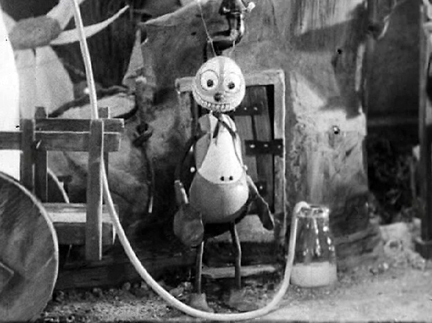
Animator Steve Stanchfield and a group of collaborators have for several years been quietly releasing professional collections of vintage animated short subjects. Stanchfield's latest release from his Thunderbean Animation label is a pressed DVD (not a burned DVD-R) with research, production and art direction aid from illustrator Stewart McKissick. As explained in McKissick's essay (included in a 12-page color insert pamphlet), stop-motion was probably the first form of film animation. Stop Motion Marvels traces the format from early in the 20th century through 1971. In addition to some primitive examples, novelty films from the twenties and a number of definite works of art, the collection includes a George Pal Puppetoon and a sampling of 1950s TV commercials, including that old Brylcreem ad with the jingle "a little dab'll do ya". Several of the shorts carry expert commentaries. In what amounts to a unique bit of film archeology, the collection also reveals a series of undiscovered films called "The Kinex Collection". Early Experiments The trick film Princess Nicotine (J. Stuart Blackton, 1909) uses forced perspective to visualize a pair of fairies that nest in a gentleman's pipe tobacco. One sequence animates matchsticks and rose petals in a basic but effective manner. Another trick film is The Automatic Moving Company (Romeo Bossetti, 1912), in which a room-full of furniture "moves" itself by the magic of stop-motion. Watch carefully and you can isolate a frame where the animator-filmmaker accidentally got caught on camera. Miracles in Mud: Swat the Fly (1915) is a clay animation film in which unseen hands invisibly sculpt various clay faces (ethnic stereotypes!), each of which is 'bothered' by a fly that lands on its nose. Prehistoric Poultry (1917) is one of the first film shorts by Willis O'Brien, later the creative dynamo behind the silent The Lost World and King Kong. O'Brien uses articulated puppets of cavemen and dinosaurs to tell a simple comedy story, animating everything on elaborate miniature sets. The impressive George Washington modeled in Clay (Virginia May, c. 1927) is another 'magic sculpting' piece in which various artistic bas-reliefs of our first president are built in clay. It's hard to say for certain, but these may have been filmed by starting with a finished sculpture and animating its destruction ... ? All Sorts of Shorts 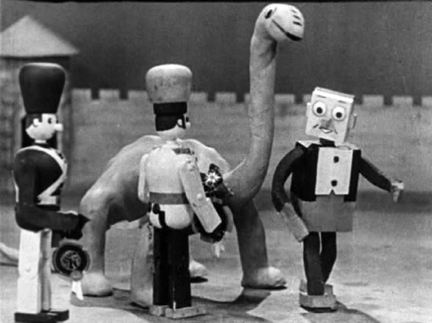
European artists dominate this section of technically elaborate animations, mostly from the 1930s and 40s. Toyland Ice Capades (Howard H. Moss, 1917) appears to be a short animation re-purposed as a fantasy played out in a New York store window. A commentary by Ken Priebe and Steve Stanchfield explains that Moss made a series of these pictures. Dolly Daisy in Hearts and Flowers (Howard H. Moss, 1930) is a Warners Vitaphone short for which no audio discs have survived -- presumably it worked with a music track. The encoding includes a Priebe and Stanchfield commentary. Ken Priebe does solo commentary on Peanut Vendor (Len Lye, 1933), a bizarre fragment featuring a grotesque monkey character singing the title song, while a palm tree behind him sways to the music. Painted replacement faces allow the monkey to form words. George Pal's technically polished Puppetoons are represented by The Sky Princess a Technicolor spin on the Sleeping Beauty story. The commentator is marionette and puppet expert Bob Baker, who actually worked on the 1942 production. Baker recounts the grueling working conditions (hot stages, reflective stage pieces requiring black tenting over the sets) and producer Pal's problems with the unions, which feared that the Puppetoons would supplant traditional animation. George Pal had begun his career in Europe, and the collection includes works by two other continental artists. The Czech Ferda Mravenec (Ferda the Ant) (Hermína Týrlová, 1944) is a beautifully designed and animated musical story about some musical insects, with lots of moving camerawork. Stop-motion animator Jim Danforth's commentary focuses on the harsh anti-artistic political climate under which Czechoslovakian artists labored. Ferda was filmed when the country was a Nazi protectorate, and the next short subject, Týrlová's adorable Rock a Bye Baby (Ukolebavka / Lullaby (1948) was made when the even more oppressive Communist authorities were in power. Rock a Bye is a charming concoction in which a live-action baby is entertained by a toy that comes to life. Mecki Introduces Himself (Mecki stellt sich vor) (Diehl Bros.,1952) is almost a public relations film for a kinder and gentler postwar Germany. Mecki, a talkative hedgehog, is first presented in an impressive behind-the-scenes look at the animation studio. He then comes to life to tell stories about his family, each of which carries a positive social lesson -- don't play on the highway, etc. Mecki even makes a Christmas plea for international peace! The animation is extremely smooth and polished. Commercials 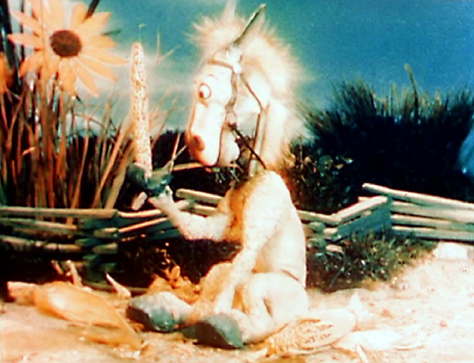
The commercial section shows what happened to the art of stop-motion: it was swallowed up by commerce. Until the 1970s and Star Wars many of Hollywood's aspiring arts 'n' crafts animators, special effects people and disciples of Ray Harryhausen had little choice but to work in film commercials. Stop-motion saw heavy use especially in the 1950s. Lucky Strikes Cigarettes (Jam Handy Productions, 1949) presents an army of marching cigarettes (something's truly sinister about that). But the voiceover script lets us know that Lucky Strikes ads are the source of the Bugs Bunny gag line, "So round, so firm, so fully packed!" - it was originally a sales slogan. A color Camel Cigarettes (c. late 40s) spot, seen here in work print form, is highly polished -- the Camel character was already being used in a context that might appeal to children. A butter commercial (c. 1956) is a nightmarish item that presents four talking cream bottles telling us -- repeatedly -- that each pound of butter contains four pints of cream. A Brylcreem (1953) ad has the familiar jingle acted out by romantic puppets, and real hair being 'animated' as it is combed into place. Why we're supposed to think that women would love to run their fingers through hair made stiff with pomade, is anybody's guess. A Chocks Vitamins (1965) spot is typical of what played on Saturday morning cartoon shows, while Glo Coat Floor Wax (1966) animates a magical Plexiglass shield to represent a tough wax barrier growing under a suburban kid's dirty feet. 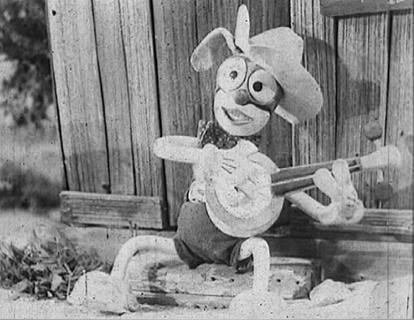
From 1971 is David Allen's legendary King Kong 411 Volkswagen (1972) commercial. The monster hauls both a blonde and a biplane down from the Empire State Building, and finds that his new car has room to store both. Allen is a particularly talented animator who got to do feature film work only infrequently. His Burbank studio was the equivalent of an artist's salon for animators, special effects and makeup people. A special last section is devoted to an elusive group of films called The Kinex Collection. Insert pamphlet writer Stewart McKissick's best guess is that the Kinex Studio was hired by Kodak to produce films to sell to owners of new 16mm home movie equipment, which made its debut late in the silent era. Stewart explains that he spent years trying to track down people who worked at Kinex, with only partial success. He did discover that the studio's output amounted to 24 short films organized into chapters that could be sold one after another. Two characters (Snap, The Gingerbread Man and Chip, The Wooden Man) each had their own series, along with a series called Daffy Doings in Doodlebugville. Each short chapter has a different gag in a different setting: Snap goes to the North Pole, Africa and the Moon. 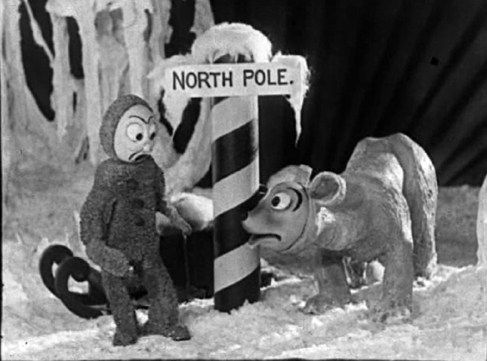
Stanchfield and McKissick have also included films they've identified as made by Kinex personnel for other companies. The fairly standard reading of Red Riding Hood (1925) appears to be a Kinex film made before the company actually came together. Pepper the Pup (1931), Horse Laffs (1934) and Hector the Pup are all by an animator named John Burton, and show the Kinex style being raised to higher levels of sophistication. In Hector the Pup the quality of the puppet animation is equal of work being done anywhere. Stewart explains some of the detective work that went into trying to track down more information on Kinex, Burton and other credited contributors, an effort that mostly ends in frustration. But 19 of the 24 Kinex films are here. Thunderbean Animation's DVD of Stop Motion Marvels! is a good transfer and encoding of material picked up over years of scavenging. The earliest films look reasonable for their age but most of the examples are rather good archival-quality prints. Thunderbean has given the set an attractive menu system, and the color insert pamphlet provides needed insights into the individual productions. The German short Mecki Introduces Himself has been outfitted with removable subtitles. For fans of stop-motion, this is a recommended disc.
On a scale of Excellent, Good, Fair, and Poor,
Stop Motion Marvels! rates:
Reviews on the Savant main site have additional credits information and are often updated and annotated with reader input and graphics. Also, don't forget the 2010 Savant Wish List. T'was Ever Thus.
Review Staff | About DVD Talk | Newsletter Subscribe | Join DVD Talk Forum |
| ||||||||||||||||||